Corona self-test made easy
Find out how to properly test yourself and what you can do to get safely through the pandemic!
In the Corona pandemic, we face so many changes and regulations, it's not easy to always keep track. And then there are those tests. They are supposed to bring us more freedom and security. But which tests are there and how exactly do they work? Rapid test and self-test - that's what we hear often. But why can I do some of them at home and why do I have to go to a test center or pharmacy for others? Don't the tests just require me to pick my nose and spit anyway? It's not that simple and yet it's easy!
Many questions. We know that everyday life with Corona rapid tests is not that easy. That's why we want to support you in protecting yourself and your fellows with the Corona rapid tests. Find out which self-tests are available and how to test yourself correctly.
Here it goes:
"Now I'm testing myself!"


WHICH HOME TESTS ARE AVAILABLE?
At the moment, two types of Corona rapid tests are mainly used for self-testing. These are the so-called "nose picker" and the colloquial "spit test". These are rapid antigen tests that have been approved for home testing by the Federal Institute for Drugs and Medical Devices. Both tests are particularly easy to use and show the result after 15-20 minutes, depending on the manufacturer.
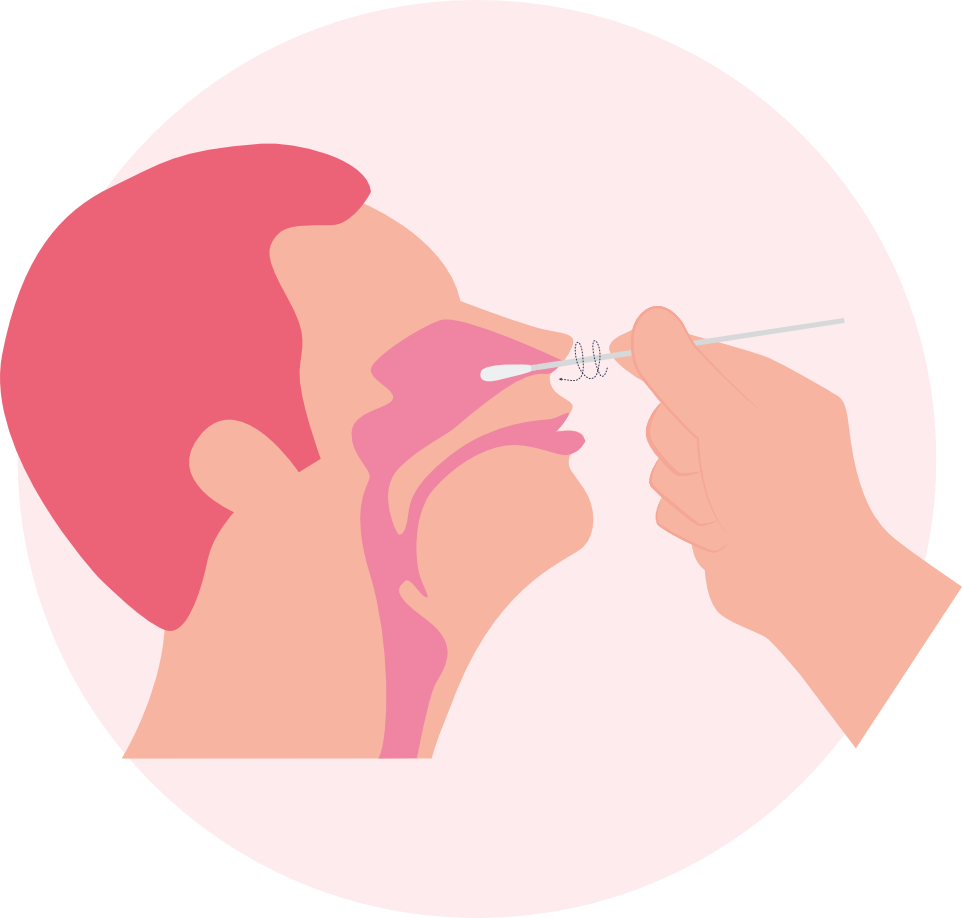
Nose Picker
With the nose picker, a swab is taken from the front of the nose (approx. 2 - 2.5 cm deep) with the help of a stick. The sample is then mixed with a liquid and placed on a test cassette.
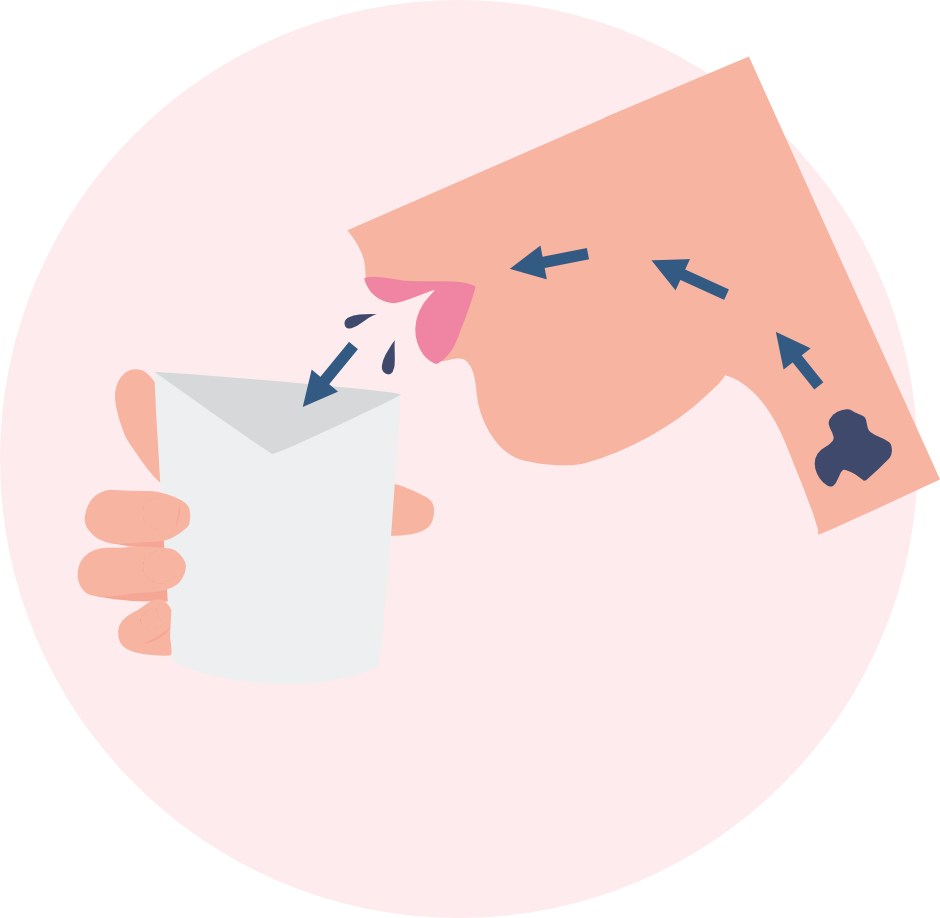
Spit Test
The spit test involves spitting deep throat saliva into a container. The sample is then mixed with a liquid and placed on a test cassette.
HOW DO YOU PROPERLY TEST YOURSELF?
The two self-tests are particularly easy to use, but there are a few pitfalls that can affect the validity of your test. Simply picking your nose or spitting into the bag is not enough, even if the names of the two tests suggest it is. In the following you will find the general procedure, what you should pay attention to and a few small tips when using the two self-tests.
Important: Always follow the instructions for use provided by the manufacturer of your self-test exactly, as the individual steps may vary slightly depending on the manufacturer. The following illustrations do not replace the instructions for use of your self-test.
NOSE PICKER
Taking the sample from the nose
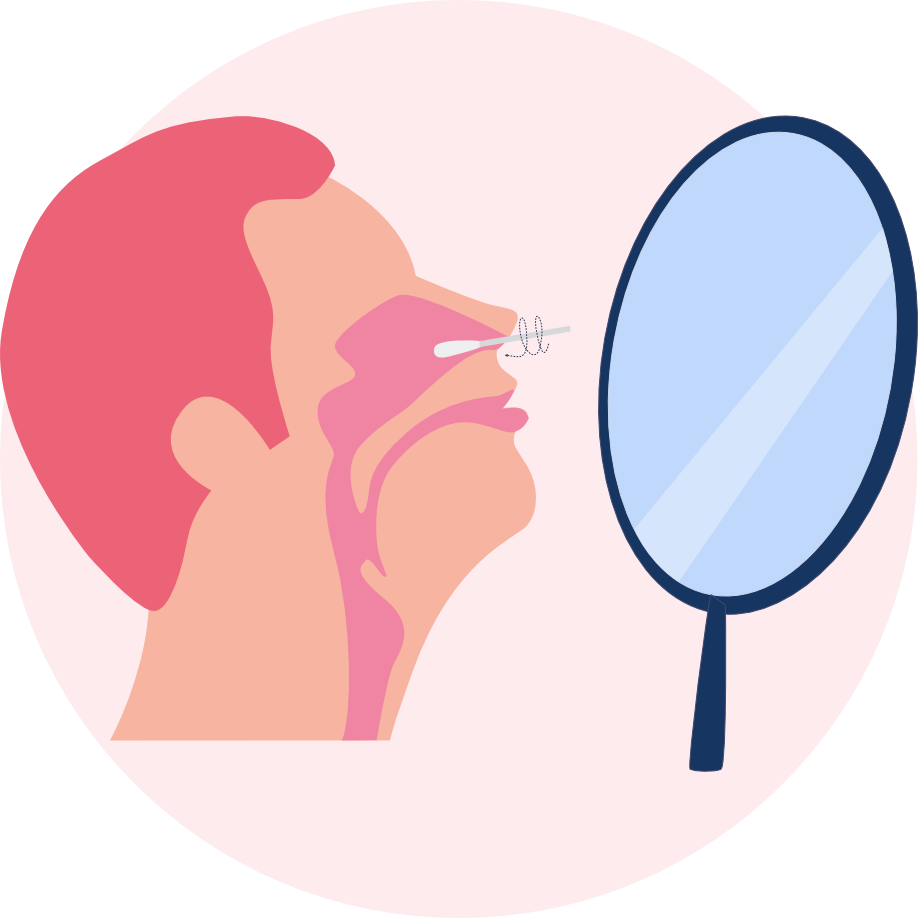
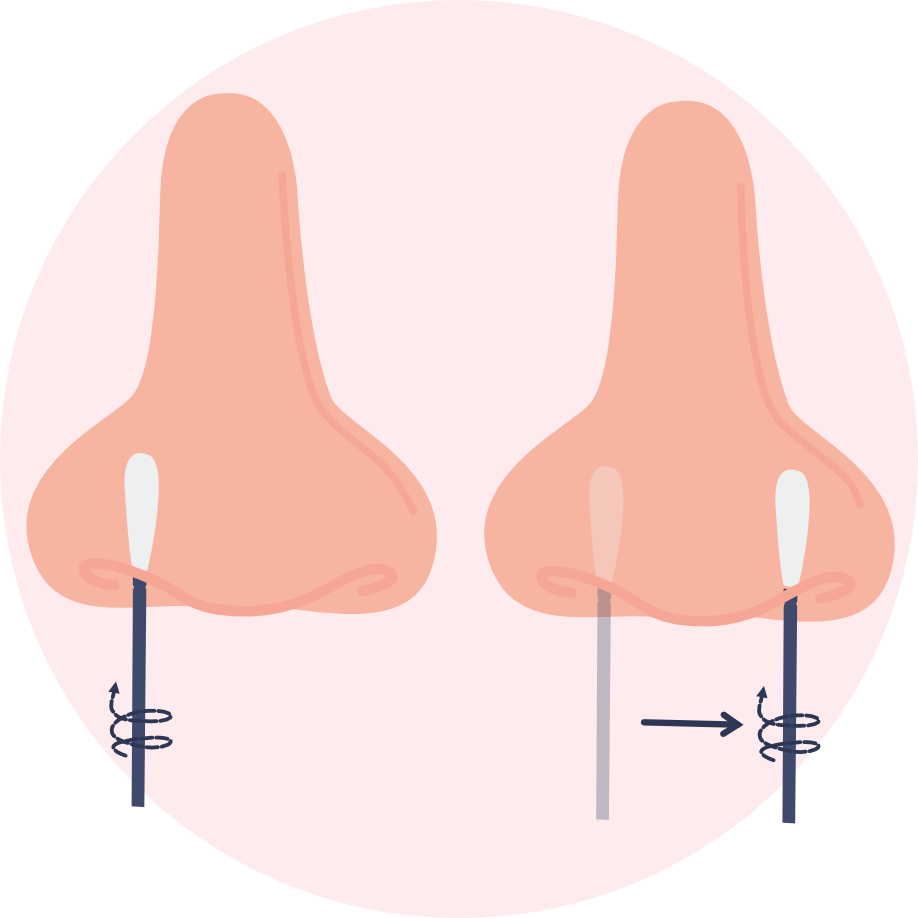
To take the sample from the front of the nose, insert the cotton side of the stick about 2 - 2.5 cm into one nostril. The rod must now be turned in the nose and pressed against the nasal wall. Then do the same again with the same stick in the other nostril.
- Important:
This is unpleasant, but it must not hurt! So do not insert the stick too deep into the nose. However, if the sample is only collected at the very front of the nose, it may happen that not enough meaningful sample is collected.
- Tip:
- Make a mark at 2 - 2.5 cm (including the cotton tip) on the stick. Be careful not to touch the cotton area with the ruler, paper or other objects.
- Do the sampling in front of a mirror, as it is easier to judge where you are with the stick in your nose.
Mixing sample with test liquid


Next, the stick must be inserted into the test tube with the test liquid so the sample mixes with the test liquid.
- Important:
It is not enough to just insert the stick briefly into the liquid in the tube. The stick must remain in the tube long enough for sufficient sample to remain in the tube.
- Tip:
- Set a timer to at least 1 minute so that the stick remains in the test liquid for a sufficiently long time.
- Press the inside of the stick against the walls of the tube so that the sample remains suspended. Also squeeze the tube itself slightly to dissolve even more sample into the liquid.
- Many rapid antigen tests have round holes punched out on the test packaging so that you can place the test tube safely at any time.
Dripping sample liquid onto the test cassette
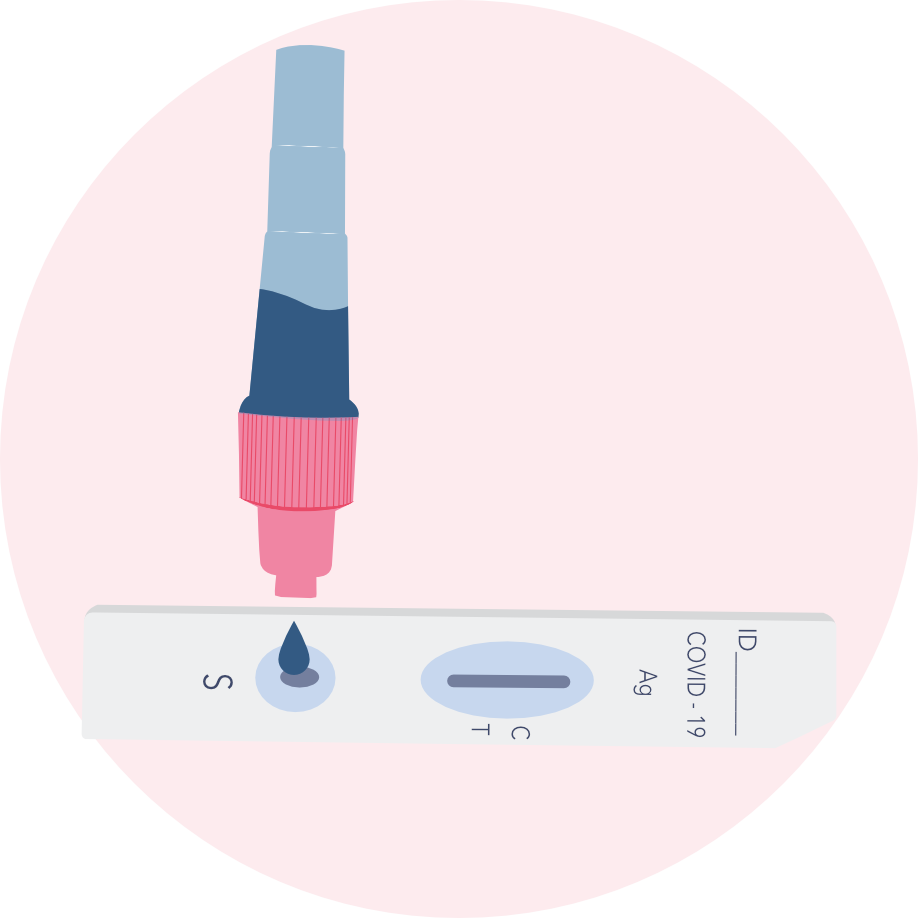
Now the liquid with the sample must be dribbled onto the test cassette. The exact number of drops varies depending on the manufacturer. Usually it is between 2 and 4 drops.
- Important:
It is important to apply exactly as many drops as indicated in the instructions for use of your self-test to the test cassette. Too little or too much test fluid can lead to an invalid test result. In this case, you must repeat the test with a completely new test kit.
Waiting for the test result
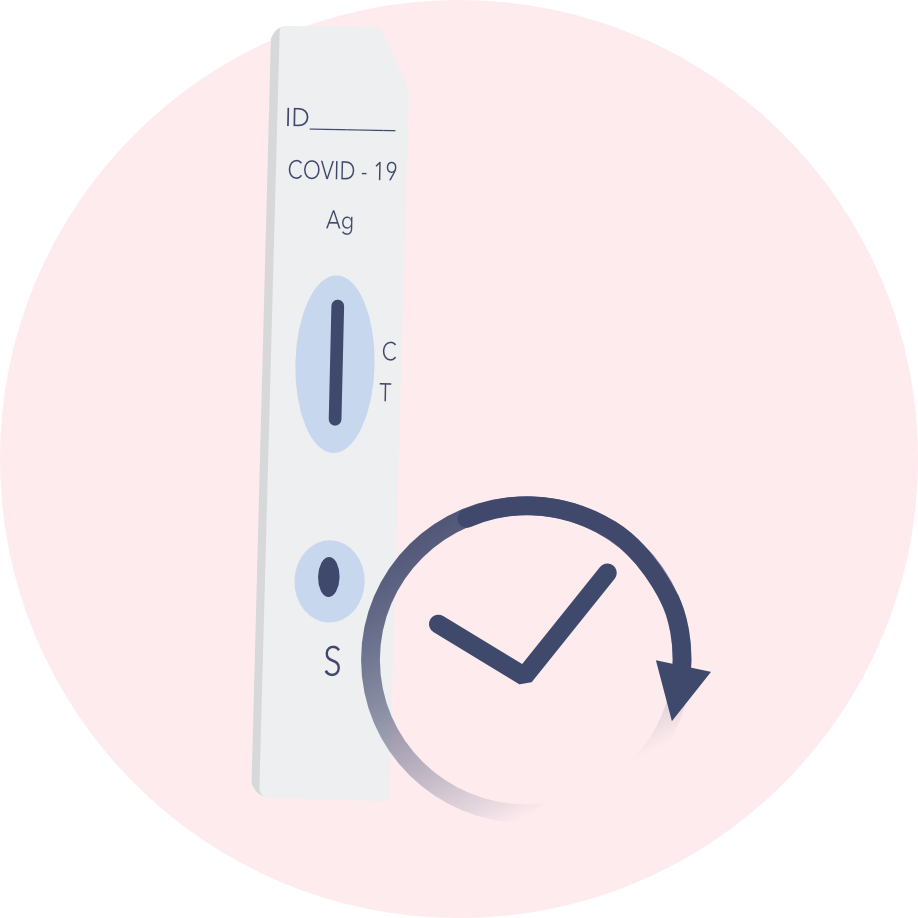
Now you have to wait, because you can only read the result of the self-test after 15-20 minutes, depending on the manufacturer. You can find the exact time in the instructions for use of your self-test.
- Important:
- After approx. 1 minute, the control strip appears at "C", but this is not yet the result! In any case, depending on the manufacturer, you have to wait 15 - 20 minutes until you can read the result!
- But don't wait too long, because depending on the self-test, the result is invalid after 20-30 minutes and can no longer be read reliably.
- Tip:
Set a timer so that you can reliably read the result!
SPIT TEST
Collecting pharyngeal saliva as a sample


In order to collect the sample for the saliva test, one must extract deep throat saliva and spit it into a container.
- Important:
It is not enough to simply spit into the container. The saliva for the spit test must come from the deep throat saliva, as the virus is detectable in the back of the throat.
- Tip:
The best way to get the saliva out of the deep throat is to make a deep "CHRUA" sound beforehand. This loosens the deep throat saliva and it can be regurgitated.
Mixing saliva with the test liquid
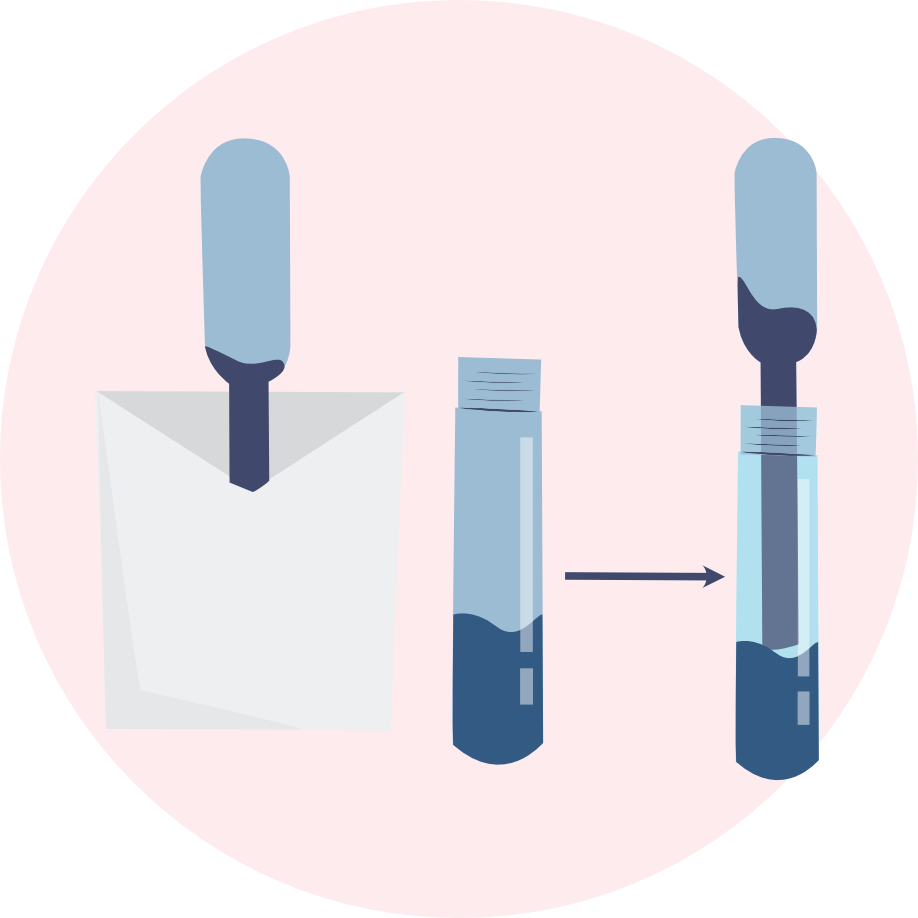
Now the saliva must be mixed with the test liquid in the test tube. Tests with a collection container have a pipette for this purpose. With this, the saliva can be easily and cleanly transferred into the tube. In tests with a funnel attachment on the tube, the saliva is spat directly into the tube. Then add the test liquid and gently swirl the closed tube so that the liquids mix.
- Important:
- Make sure that there is not too much saliva in the tube. There are usually markings on the tube for this purpose and you will find the corresponding information in the instructions for use.
- You should also make sure that you work cleanly and that no saliva gets on the outside of the test tube.
Dripping sample liquid onto the test cassette

Now the liquid with the sample must be dribbled onto the test cassette. The exact number of drops varies depending on the manufacturer. Usually it is between 2 and 4 drops.
- Important:
It is important to apply exactly as many drops as indicated in the instructions for use of your self-test to the test cassette. Too little or too much test fluid can lead to an invalid test result. In this case, you must repeat the test with a completely new test kit.
Waiting for the test result

Now you have to wait, because you can only read the result of the self-test after 15-20 minutes, depending on the manufacturer. You can find the exact time in the instructions for use of your self-test.
- Important:
- After approx. 1 minute, the control strip appears at "C", but this is not yet the result! In any case, depending on the manufacturer, you have to wait 15 - 20 minutes until you can read the result!
- But don't wait too long, because depending on the self-test, the result is invalid after 20-30 minutes and can no longer be read reliably.
- Tip:
Set a timer so that you can reliably read the result!


How do you interpret the results?

Negative test result:
Only 1 line appears at the C mark.
What next?
A negative result is only a snapshot and does not mean that you are not infected! It only means that you are not contagious at the moment.
You must continue to follow the AHA-L rules (distance, hygiene, everyday masks, ventilation). This is also for your safety.
If you still feel sick, please do another test 1 or 2 days later or have a PCR confirmation test done.
If in doubt, please consult your family doctor.
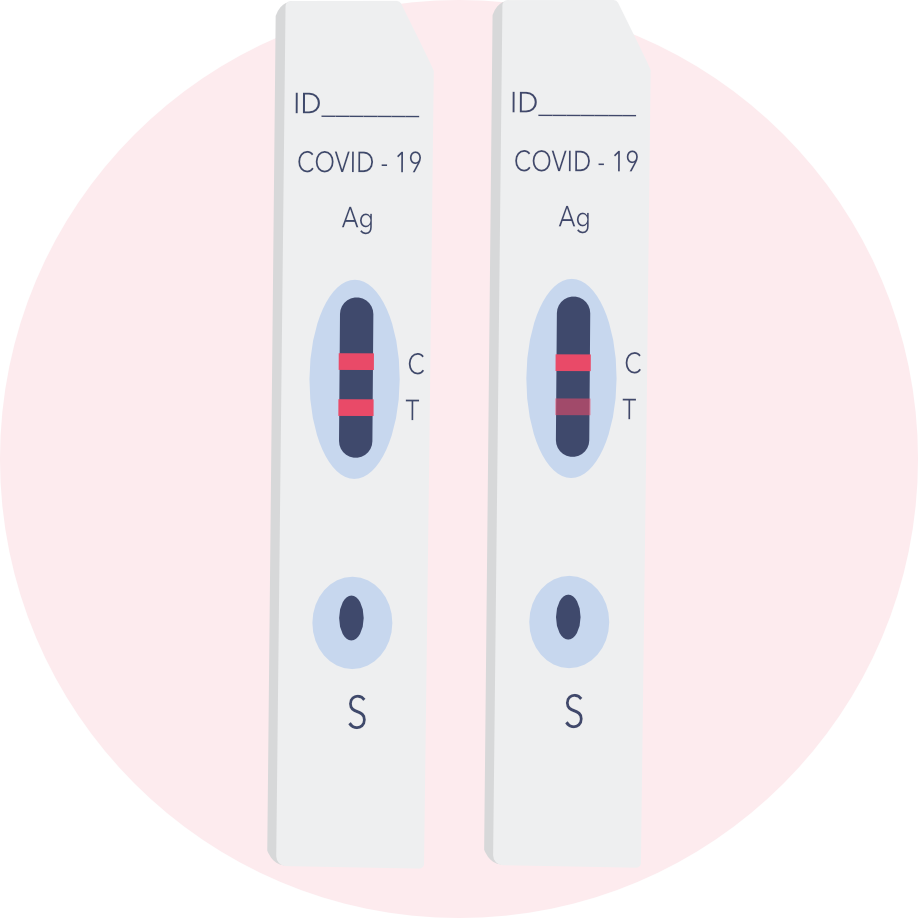
Positive test result:
2 lines appear. 1 line at the C mark and 1 line at the Ag/T mark.
Important: The result is positive even if one of the lines is only very slightly coloured.
What next?
You are suspected of being infected with SARS-CoV-2. You must report a positive test result to the health department. Call the health department or your doctor immediately. You can also call the medical on-call service at 116117 in Germany.
Have a PCR confirmation test done and stay at home. You should now stay away from other household members and everyone should wash their hands more often. Please check local guidelines for self-isolation.

Invalid test result:
No line appears or only 1 line appears at the Ag/T mark.
What next?
Repeat the test with a new test set.
Note: If several tests in a pack are invalid, return the tests to your distributor. Please contact your doctor or a COVID-19 testing centre.
How does the virus spread?

Aerosols & droplets
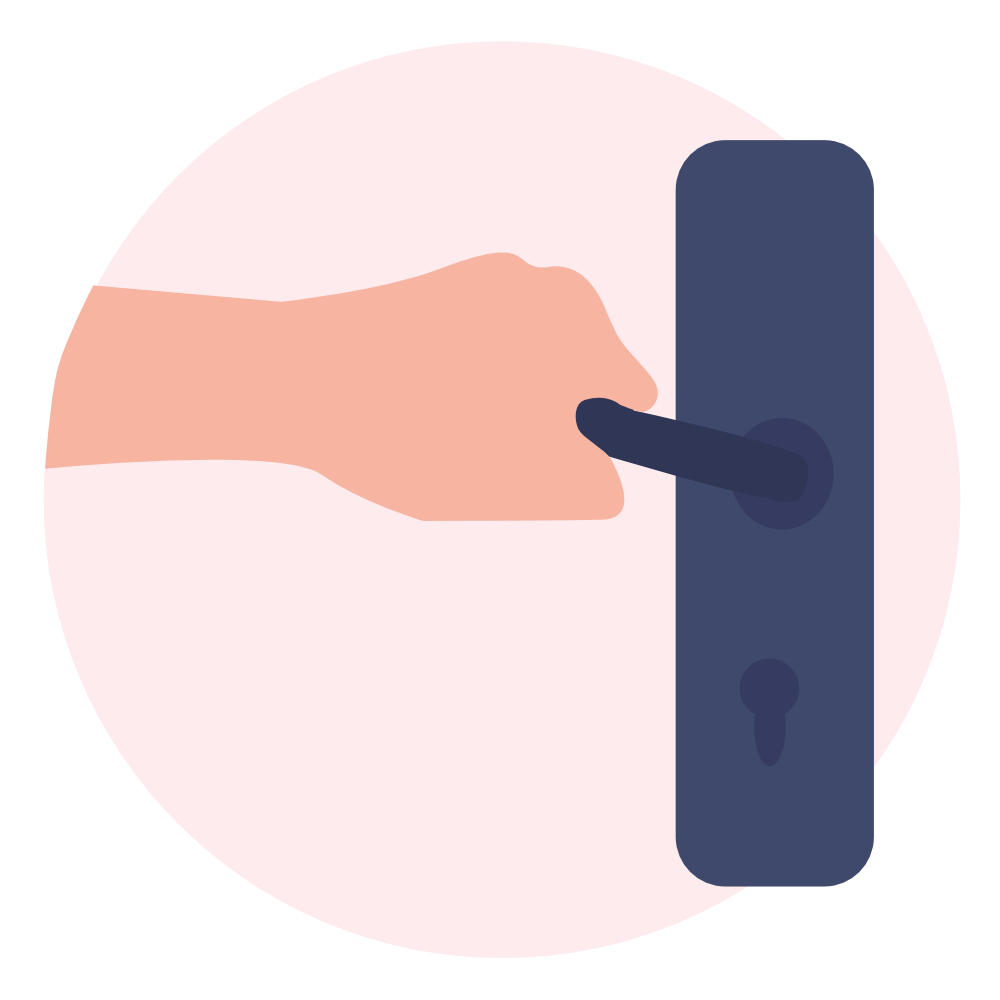
contaminated areas

aerosols & droplets
Especially when speaking, coughing, sneezing or singing, viruses can be spread in the air through droplets and aerosols. This is especially critical indoors. While droplets sink to the ground more quickly, aerosols can spread quickly in the room and be inhaled.

contaminated areas
Transmission through contaminated surfaces can occur especially in the immediate vicinity of infected persons, as the viral load is particularly high there. Viruses can remain viable, especially on smooth surfaces, and remain infectious for several hours.


How can you protect yourself?

wear a mask
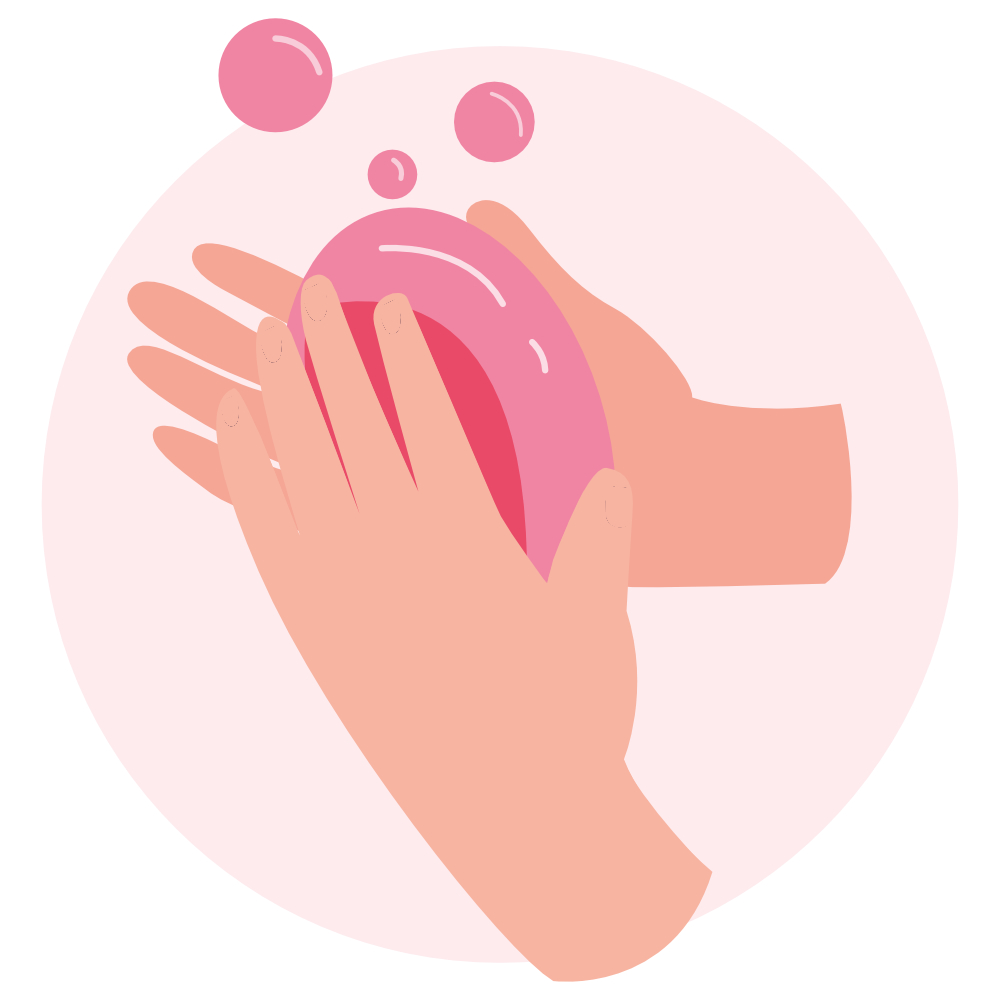
wash your hands

ventilate regurarly

Avoid crowds

stay at home
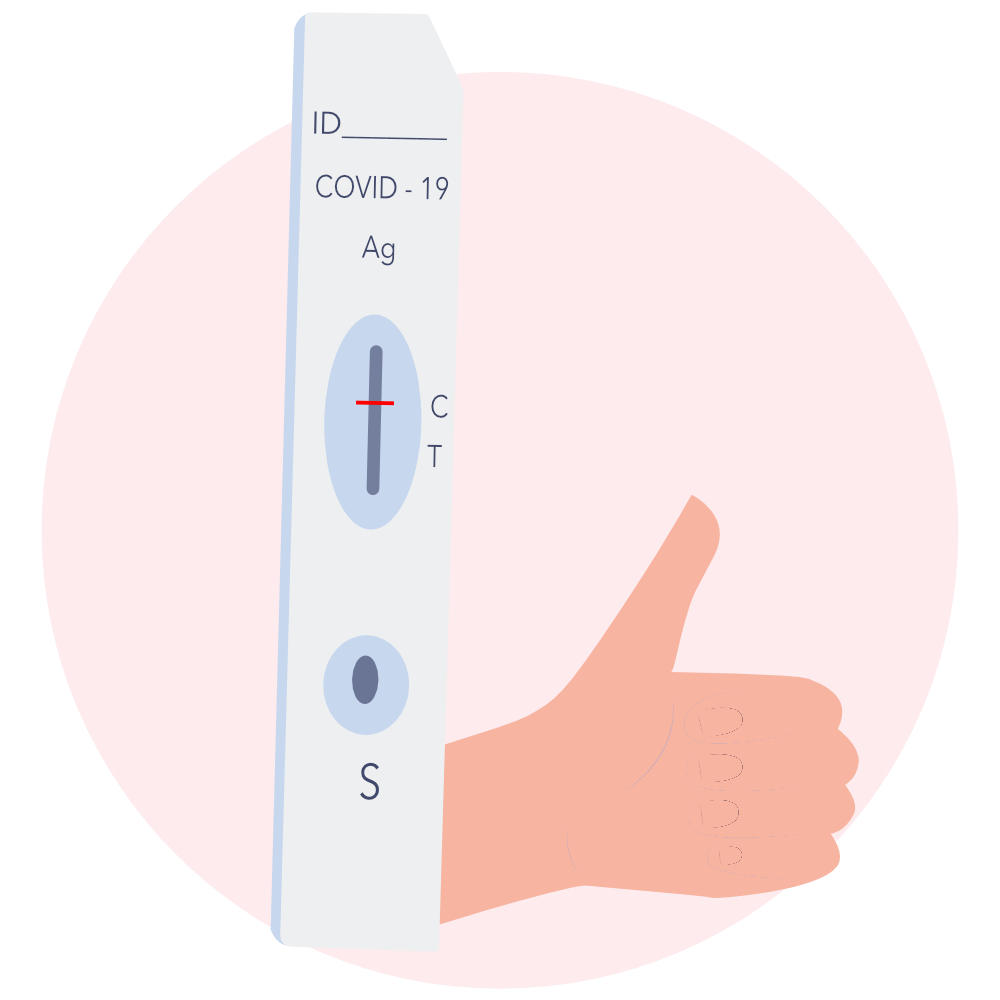
test yourself

keep distance

wear a mask

wash your hands

ventilate regurarly

avoid crowds

stay at home

test yourself

keep distance
Frequently Asked Questions (FAQ)
The minimum age to be able to perform the self-test without adult supervision varies depending on the self-test. In most cases, the age is between 14 and 18 years. The exact age limit must be taken from the instructions for use of the respective test/manufacturer!
Younger persons must perform the test under adult supervision or have an adult perform the test.
Currently, there are two types of self-tests that are most commonly used. These are the colloquially called nose picker and spit test. The nose picker is a rapid antigen test for home testing, in which the sample is taken from the front of the nose with the help of a stick. The spit test is a rapid antigen test for home testing in which the sample is taken from the deep throat saliva by spitting it out into a container.
The PCR test is currently the safest way to detect an infection with the Corona virus. It may only be performed by medical personnel and the evaluation is done in the laboratory, so the result is available after a few hours at the earliest. The sample is taken through a deep throat and/or deep nasal swab, which is why the test may only be carried out by medical personnel.
The antigen rapid test is not as accurate as a PCR test, but the result can usually be read after 15-20 minutes. This test may also only be carried out by medical or trained personnel. There are different ways of taking samples.
The self-test is a rapid antigen test that is particularly easy to use. This means that even people without special medical knowledge can easily carry out this test at home. There are currently two options for taking samples. In the self-test known as the "nose picker", the sample is taken from the front of the nose, and in the so-called "spit test", the sample is taken from the deep throat saliva. Here, too, the result can be read after 15-20 minutes, depending on the test.
The specificity of a test indicates how likely it is that someone who is actually not infected will also be identified as not infected. For example, with a specificity of 96%, 96 out of 100 people who take this test and are also actually not infected with the coronavirus will be tested as negative.
The sensitivity of a test indicates how likely it is that someone who is actually infected will also be recognized as infected. For example, with a sensitivity of 96%, 96 out of 100 people who take this test and are actually infected with the coronavirus will test as positive.
While you are taking the sample from your nose or collecting saliva for the spit test, it is helpful to be able to put the test tube down safely. For this purpose, you will find helpful punch-outs (small holes) on the outer packaging of most tests, into which you can easily place the test tube.
If your skin or eyes come into contact with the test fluid, rinse/flush the affected area thoroughly with water. If symptoms persist, please contact a doctor.
Depending on the rapid test/self-test, you need to drip 2-4 drops of the test liquid into the well of the test cassette. Please make sure to drip EXACTLY THE NUMBER OF DROPS REQUIRED into the test cassette according to the instructions for use. Too much or too little test fluid may invalidate the test and you will need to do a new test with a new test kit.
It is important that you let the stick with the sample soak long enough in the test liquid in the sampling tube. Meanwhile, press it against the wall and the bottom of the tube. Squeeze the outside of the tube with your fingers as you pull the stick out and wipe the stick along the wall of the test tube as you pull it out.
It is very important that the cotton side of the test stick remains sterile and is therefore not touched or comes into contact with any objects. The test may otherwise become invalid. Also, do not dip the cotton side of the stick into the test fluid before taking the sample from the nose to avoid skin contact with the test fluid. If the stick becomes contaminated, please dispose of it accordingly and use a new one for your test.
Even though this rapid antigen test is colloquially called a "spit test", it is not enough to simply spit into the sachet. The virus cannot be detected so easily in saliva only from the mouth. It is therefore important that the saliva for the spit test comes from the deeper throat, because the virus settles in the throat. The best way to get this saliva up is to clear your throat and make a kind of deep "krua" sound.
No. Please use the test only until the expiry date printed on it.
No. The test cassette can only be used once. After opening the foil packaging, the test cassette must be used for the rapid test within one hour.
The result of the self-test is only meaningful for the day it is taken. It shows whether you are currently contagious. If you have plans for the next day, you have to retest yourself to be really sure that you are not contagious.
Yes, the self-test only shows whether you are currently contagious and could therefore possibly infect other people. The result does not mean that you are not or have not been infected with SARS-CoV-2.
The test result is invalid if no line appears on the test cassette or if only a line appears at the Ag mark (antigen) or T mark (test line). In this case, the test is invalid and a new test must be done with a completely new test kit. If it happens with several tests in a pack, take the tests back to your distributor. Contact your doctor or your COVID-19 test centre.
The test result is positive if two lines appear on the test cassette. One at the C mark (control) and one at the Ag mark (antigen) or T mark (test line). Note: The result is also positive if one of the two lines is only very slightly visible.
It is now suspected that you are infected with the coronavirus. Please remain calm. A positive result does not automatically mean that you will get sick.
- You must report a positive test result to the public health department.
- Please call your local health office or your doctor right away. You can also call the medical on-call service at 116117 in Germany. Important: Only go there if you are asked to do so. Have a PCR confirmation test done.
- Stay at home and also stay away from other family/household members. All of you should now wash your hands more often and ventilate more frequently. Find out about local guidelines for self-isolation.
The test result is negative if only 1 line appears at the C mark (Control) on the test cassette. Note: A negative test result is only a snapshot and does not mean that you are not infected. It only means that you are not infectious at the moment and cannot infect other people. This can be different again afterwards. We therefore recommend that you repeat the test regularly, especially before you have contact with other people, to make sure that you do not infect them.
With a rapid antigen test, the result is only valid on the day the test was taken. It shows for the next 6 hours whether you can infect a person or not. This can be different again afterwards. Therefore, we recommend repeating the test regularly. Especially before you have contact with other people to make sure that you do not infect them.
The test results of the self-tests can be read after different times depending on the manufacturer. Normally, the result can be read after 15 or 20 minutes, depending on the test. After 20 to 30 minutes, depending on the manufacturer, the result may no longer be read off, as it is no longer meaningful. However, the exact times must be taken from the instructions for use of the respective test/manufacturer!
You should take about half an hour for the self-test. After you have taken the sample, you have to wait between 15 and 20 minutes, depending on the test, until you can read the result.
So far, there is no evidence that people have been infected with SARS-CoV-2 by their pets.
Source: https://www.bundesregierung.de/breg-de/themen/coronavirus/informationen-zum-coronavirus-1734932
So far, there are mainly four known virus mutations. These are Alpha (B1.1.7), which was first detected in the UK in September 2020, Beta (B1.351), which was first detected in South Africa at the end of 2020, Gamma (P.1), which was first detected in Brazil and Delta (B1.617.2), which was first detected in India.
Source: https://www.rki.de/DE/Content/InfAZ/N/Neuartiges_Coronavirus/Virusvariante.html;jsessionid=F0C7853CA92810DA6FC3317FD14575B6.internet121?nn=2444038
Covid-19 = Corona Virus Disease 2019
SARS-CoV-2 = Severe Acute Respiratory Syndrome
Coronaviruses are not new viruses. Coronaviruses were already discovered in the 1960s. However, the novel coronavirus that is currently responsible for the pandemic is a new, previously unknown strain of the virus. This new type of coronavirus is called SARS-CoV-2 (Severe Acute Respiratory Syndrome).
The disease caused by the SARS-CoV-2 virus is called Covid-19 (Corona Virus Disease 2019). The typical symptoms of this disease are fever, cough, cold, loss of sense of taste and/or smell, shortness of breath, sore throat, headache and pain in the limbs.
Source: https://www.bundesregierung.de/breg-de/themen/coronavirus/informationen-zum-coronavirus-1734932
The virus belongs to the coronaviruses, which were first found in the 1960s. The novel coronavirus is a new strain of the previously known SARS pathogen from 2002.
Source: https://www.bundesregierung.de/breg-de/themen/coronavirus/informationen-zum-coronavirus-1734932
The 7-day incidence shows how many people per 100,000 people in a municipality, city, state, country, etc. have been infected in the last 7 days. This makes it possible to compare the incidence of infection for different countries, cities or regions.
The abbreviation BfArM stands for the Federal Institute for Drugs and Medical Devices in Germany. The BfArM provides a list of all tests which, according to the manufacturer, fulfil the minimum criteria defined by the Paul Ehrlich Institute in consultation with the RKI. This list only contains antigen rapid tests which have been notified to the BfArM by the manufacturer or distributor.
The antigen rapid tests on the BfArM list are reimbursable according to the Coronavirus-Testverordnung-TestV.
With regard to the self-tests, the BfArM issues the special approvals for home testing without CE marking for a limited period of time according to § 11 para. 1 MPG (Medical Devices Act) in Germany. For the special approval of the antigen rapid tests for home use, the BfArM not only includes the evaluation of the Paul Ehrlich Institute, but also whether sampling and testing are comprehensible and easy to perform for laypersons according to the instructions for use.
Source: https://www.pei.de/DE/newsroom/dossier/coronavirus/coronavirus-inhalt.html;jsessionid=09B536A7388CE2341E5768C21C36E201.intranet231?nn=169730&cms_pos=3
The difference between an infectiologist, epidemiologist and virologist lies primarily in their respective areas of expertise.
Infectiologists are specialists in infectious diseases and deal with their diagnosis, research and therapy. This includes not only viral diseases, but also bacterial diseases.
Virologists, on the other hand, only study viruses and viral diseases. They study how viruses react to drugs and disinfectants and therefore work mainly in the laboratory.
Epidemiologists research the spread of diseases. In doing so, you deal with the causes of the spread and the consequences for the population. They study not only diseases that are infectious, but also chronic diseases such as diabetes.
Under the motto "Open with Safety", the University City of Tübingen launched its own strategy for dealing with the Corona Pandemic in March and April 2021. This pilot project was approved by the state of Baden-Württemberg and implemented by the city of Tübingen together with the German Red Cross in the district of Tübingen. In addition, the project was scientifically accompanied by the University Hospital of Tübingen. On 24 April 2021, the pilot project ended after 6 weeks due to the entry into force of the federal emergency brake.
The aim of the project was to provide the means to fight the pandemic quickly and unbureaucratically and thus better protect the risk groups. In order to be able to carry out nationwide rapid tests and thus detect the sources of infection more quickly and interrupt chains of infection, the city had set up 9 test centres where every citizen could be tested 6 days a week. Retail shops, outdoor catering, body-related services as well as cultural institutions (theatres, cinemas) were opened for guests with a daily negative Corona rapid test. The so-called "Tübingen Day Ticket" was issued as proof.
The abbreviation PEI stands for the Paul Ehrlich Institute. Together with the Robert Koch Institute, the PEI has drawn up a list of minimum criteria that antigen rapid tests must meet according to the manufacturer's specifications. If a test fulfils all criteria according to the manufacturer's information, it is listed by the BfArM. This list only includes antigen tests that have been reported to the BfArM by the manufacturer or distributor. The Paul Ehrlich Institute also conducts comparative experimental studies on the sensitivity of the antigen rapid tests.
Source: https://www.pei.de/DE/newsroom/dossier/coronavirus/coronavirus-inhalt.html;jsessionid=09B536A7388CE2341E5768C21C36E201.intranet231?nn=169730&cms_pos=3
The abbreviation RKI stands for the Robert Koch Institute. In consultation with the Robert Koch Institute, the PEI has defined minimum criteria for rapid antigen tests.
Source: https://www.pei.de/DE/newsroom/dossier/coronavirus/coronavirus-inhalt.html;jsessionid=09B536A7388CE2341E5768C21C36E201.intranet231?nn=169730&cms_pos=3
Current figures at a glance

Source: Worldometers
Do you still have questions?
Write us using our contact form!
